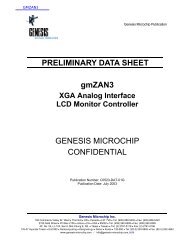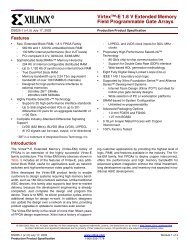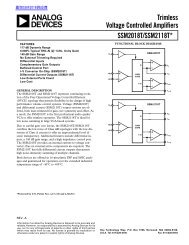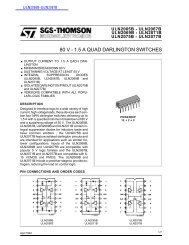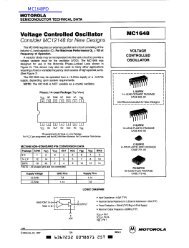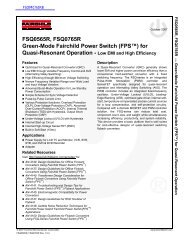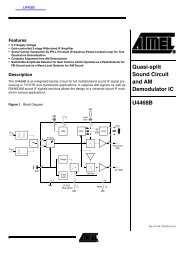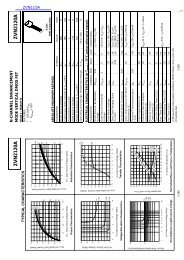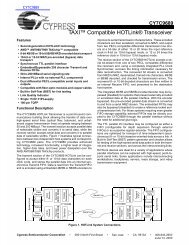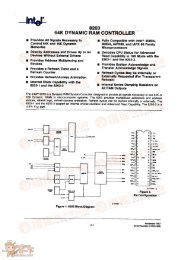You also want an ePaper? Increase the reach of your titles
YUMPU automatically turns print PDFs into web optimized ePapers that Google loves.
Numonyx <strong>Wireless</strong> <strong>Flash</strong> <strong>Memory</strong> (<strong>W30</strong>)<br />
2.0 Functional Overview<br />
This section provides an overview of the <strong>W30</strong> flash memory device features and<br />
architecture.<br />
2.1 Overview<br />
The <strong>W30</strong> flash memory device provides Read-While-Write (RWW) and Read-White-<br />
Erase (RWE) capability. This capability provides high-performance synchronous and<br />
asynchronous reads in package-compatible densities using a 16-bit data bus.<br />
Individually-erasable memory blocks are optimally sized for code and data storage.<br />
Eight 4-Kword parameter blocks are located in the parameter partition at either the top<br />
or bottom of the memory map. The rest of the memory array is grouped into 32-Kword<br />
main blocks.<br />
The memory architecture for the <strong>W30</strong> flash memory device consists of multiple 4-Mbit<br />
partitions, the exact number depending on the flash device density. By dividing the<br />
memory array into partitions, program or erase operations can take place<br />
simultaneously during read operations. Burst reads can traverse partition boundaries,<br />
but user application code is responsible for ensuring that burst reads do not extend into<br />
a partition that is actively programming or erasing. Although each partition has burstread,<br />
write, and erase capabilities, simultaneous operation is limited to write or erase in<br />
one partition while other partitions are in a read mode.<br />
Augmented erase-suspend functionality further enhances the RWW capabilities of the<br />
<strong>W30</strong> flash memory device. An erase can be suspended to perform a program or read<br />
operation within any block, except a block that is erase-suspended. A program<br />
operation nested within a suspended erase can subsequently be suspended to read yet<br />
another memory location.<br />
After power-up or reset, the <strong>W30</strong> flash memory device defaults to asynchronous read<br />
configuration. Writing to the flash memory device Read Configuration Register (RCR)<br />
enables synchronous burst-mode read operation. In synchronous mode, the CLK input<br />
increments an internal burst address generator. CLK also synchronizes the flash<br />
memory device with the host CPU and outputs data on every, or on every other, valid<br />
CLK cycle after an initial latency. A programmable WAIT output signals to the CPU when<br />
data from the flash memory device is ready.<br />
In addition to its improved architecture and interface, the <strong>W30</strong> flash memory device<br />
incorporates Enhanced Factory Programming (EFP), a feature that enables fast<br />
programming and low-power designs. The EFP feature provides fast program<br />
performance, which can increase the manufacturing throughput of a factory.<br />
The <strong>W30</strong> flash memory device supports read operations at 1.8 V and erase and<br />
program operations at 1.8 V or 12 V. With the 1.8-V option, VCC and VPP can be tied<br />
together for an ultra-low-power design. In addition to voltage flexibility, the dedicated<br />
VPP input provides extensive data protection when V PP < V PPLK .<br />
A 128-bit protection register can implement new security techniques and data<br />
protection schemes:<br />
• A combination of factory-programmed and user-OTP data cells provide unique flash<br />
device identification, help implement fraud or cloning prevention schemes, or help<br />
protect content.<br />
• Zero-latency locking/unlocking on any memory block provides instant and<br />
complete protection for critical system code and data.<br />
• An additional block lock-down capability provides hardware protection where<br />
software commands alone cannot change the block protection status.<br />
November 2007 Datasheet<br />
Order Number: 290702-13 9



